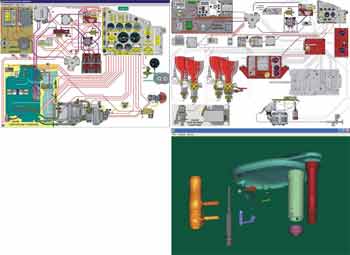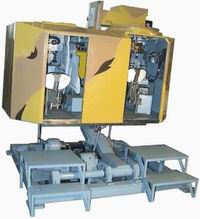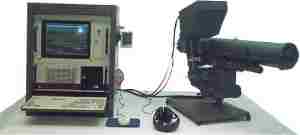Articles >>
Principles of Design of the Fighting Vehicle Crew Training Aids
Category: Training And Simulators

The latest years have seen a considerable increase in the use of computer-based equipment for training of the personnel of the Land Army, Navy, Air Force and Air Defence Force. Based on the gained experience, one can determine the most popular hierarchic structure of computer-based armoured vehicle crew training aids as well as the general principles of their design. The computer-based armoured vehicle crew training aids can be divided in the following groups:
Development, production and introduction of the simulators into the army is intended to achieve the following:
The wide use of computer-based simulators is caused by the fact that the up-to-date computers have become more or less inexpensive, and that the technical characteristics of computers make it possible to simulate real conditions rather realistically, and that the pay-back of the most expensive simulators (e.g., motion-based computer-based simulating systems) can achieved, depending on the intensity of operation, within 6 to 12 months. |
|
Technical Training Aids

The training software composed on the principles of two-dimensional animation is efficient both in individual training in computerised class-rooms and in group training in the process of lecturing. The animated image provides a visual demonstration of the principle of operation of armoured vehicle systems by means of simulating their operation. The training software composed on the principles of three-dimensional animation, and the training video films provide theoretical knowledge of the design and technical maintenance of units and systems of armoured vehicles. The practical skills in technical maintenance of units and systems of armoured vehicles can be acquired by trainees on operating training models which provide a full-scale simulation of the units and systems being studied. |
|
Individual Crewman Combat Training Aids

The individual crewman combat training aids include various complexity level simulators, viz. motion-based, static and tabletop simulators. The most efficient individual combat training aids are motion-based training simulators, the static and tabletop simulators being just their less complicated and less expensive versions. The latter are intended to develop skills in operating separate instruments (e.g., sights) being placed on a tabletop, or to further develop sensomotive skills in the static version. The motion-based armoured vehicle crewman training simulators are based on the same principle and consist of the following main components:
The motion platforms can be provided with either electromechanical or hydraulic drives. A number of well-known producers, including Krauss Maffei Wegmann of Germany, Lockheed Martin of the USA, Thales Training & Simulation of France, use platforms with hydraulic drives for their simulators. Many of them are two-level ('two-storey') ones:
This approach is caused mostly by the continuity and commonality with the aviation simulators that started to be produced much earlier. The Ukrainian developer of simulators – State-owned Enterprise Kharkiv Morozov Machine Building Design Bureau, as well as some other developers, use electromechanical drives in their motion platforms. The advantages of the electromechanical drive over the hydraulic drive are as follows:
A motion platform is usually multi-purpose and can be used for installation of any cabin containing a crewman station provided the cabin does not exceed the maximum admissible overall dimensions. |
|
Cabin Containing a Crewman Station

The observation and sighting devices, control panels and controls of the simulator are identical to those of a real vehicle, and are connected with the mathematical models of armoured vehicles by means of interface devices which can be of distributive or unitary type. The distributive type of interface device is a set of processor units fitted with a required number of analogue and discrete inputs and outputs. Each processor unit is individually built into a sight, control panel and other devices and is united by means of CAN–type interface to other units to crate a network. This version has good characteristics, but it is more expensive than the unitary-type version. The unitary interface device is a single processor unit fitted with a required number of analogue and discrete inputs and outputs. This unit receives all signals from all the devices located at a crewman station. The unitary interface unit can be either external or built-in. The external interface unit is admissible for static and tabletop simulators. It can be located outside the cabin. However, the external interface is not admissible for motion-based simulators because of the low reliability of the moving joint of the cable if the number of signal is large. The built-in unitary interface unit is the best option regarding the issues of price, quality and reliability. The interface unit of the kind is installed inside the cabin and is connected to the computer that computes the models of vehicle movement, by means of a Ethernet-cable. In this case, the high reliability is ensured. The software comprises the whole spectrum of mathematical models ranging from the simplest logical models to the complicated models of engine and vehicle movement. The mathematical models that are used in up-to-date simulators, make it possible to realistically simulate various processes, such as engine starting, vehicle movement on various types o ground, target ranging, operation of the armament stabiliser, auto-loader and ballistic computer, engagement of targets by means of various natures of ammunition, etc. Some mathematical models are matched with visualisation system and carry out computation of collisions with obstacles. The visualisation system makes it possible to display realistic three-dimensional terrain models, which are built on the basis of real digital maps, with simulation of terrain surface details, stones, grass, bushes, trees, and buildings. Visualisation makes it possible to place a large number of various types of targets on the terrain, with the virtual appearance and dimensions of the targets being matched to the real targets, as well as to display weather conditions (rain, snow, fog) and various time of the day (day, night) and various seasons (summer, autumn, winter, spring). The instructor's station enables its operator to pre-set the initial conditions (weather conditions, season time of the day), to monitor the sequence and correctness of actions of trainees at signals displayed on the monitor. The software of the computer that ensures operability of the instructor's station, makes it possible to record the actions of a trainee with the possibility of subsequent re-display and printing-out of the examination sheet. To monitor the actions of a trainee, the simulator cabin can be fitted with and video observation camera. The field of view of the camera is displayed at the instructor's station. |
|
Armoured Vehicle Crew Teamwork Training Aids

The aids of the kind include crew training simulators which are created by means of uniting the individual combat training aids (particular crewman training simulators) into a network. In this case a crew of a vehicle as a whole (tank crew, or armoured personnel carrier crew, etc.) is trained on a simulated battlefield to become a well-trained crew. The simulator of the kind makes it possible to increase the efficiency of crew teamwork under the conditions that similar to combat ones, to practise interaction both within the crew and with the superior commander (in this case the instructor acts as a superior commander). On the simulated battlefield, the crew can get involved in duel-type engagements with both simulated enemy that can return fire and with the crew of another armoured vehicle simulator connected to the same simulated battlefield. The latter is a step towards the next level of interaction training aids, viz. military unit combat interaction training simulators and inter-unit combat cooperation training simulators. |
|
Armoured Vehicle-based Military Unit Combat Interaction Training Aids and Inter-unit Combat Cooperation Training Aids

The armoured vehicle crew training simulators can be united into a network to carry out joint actions in one simulated battlefield, whatever the skills to be trained are (tactical cooperation training, column driving training, joint actions on simulated terrain that is similar to a would-be real battlefield or to a real training range). The hierarchy of this network of simulators is only limited by the financial capabilities of the customer (it may be tank platoon training simulator, or tank company training simulator, or tank battalion training simulator). |
|
Strategic Inter-branch Cooperation Training Aids

The simulators of the kind are intended for senior commanding officers, staff officers, etc., and are analogues of on-line strategy computer games. The training aids in question are based of digital maps of real terrain provided with a database containing information about the military, economic and political potential of a particular region. To arrange training of commanding officers, the NATO countries established special computer centres, which make it possible to carry out headquarters (staff) exercises inside the country and international exercises. One of the considerable disadvantages of such a training consists in the lack of involvement of rank and files that are supposed to do the actual fighting in combat. In order to eliminate the above- mentioned drawback, it is expedient to involve the rank and file as well as junior level commanders and various afore-mentioned simulators in this kind of training. It is quite probable that, in future, the development of computer-based training aids will go along the lines of uniting the simulators of various levels into one hierarchical structure. |
|
Strategic Inter-branch Cooperation Training Aids
The simulators of the kind are intended for senior commanding officers, staff officers, etc., and are analogues of on-line strategy computer games. The training aids in question are based of digital maps of real terrain provided with a database containing information about the military, economic and political potential of a particular region. To arrange training of commanding officers, the NATO countries established special computer centres, which make it possible to carry out headquarters (staff) exercises inside the country and international exercises. One of the considerable disadvantages of such a training consists in the lack of involvement of rank and files that are supposed to do the actual fighting in combat. In order to eliminate the above- mentioned drawback, it is expedient to involve the rank and file as well as junior level commanders and various afore-mentioned simulators in this kind of training. It is quite probable that, in future, the development of computer-based training aids will go along the lines of uniting the simulators of various levels into one hierarchical structure. |
|
Armoured Vehicle-based Military Unit Combat Interaction Training Aids and Inter-unit Combat Cooperation Training Aids
The armoured vehicle crew training simulators can be united into a network to carry out joint actions in one simulated battlefield, whatever the skills to be trained are (tactical cooperation training, column driving training, joint actions on simulated terrain that is similar to a would-be real battlefield or to a real training range). The hierarchy of this network of simulators is only limited by the financial capabilities of the customer (it may be tank platoon training simulator, or tank company training simulator, or tank battalion training simulator). |
UK Army vehicle crew training school opens in Germany
03.11.2010
Head of SOE KMDB spoke about execution of contract for supply of BTR-4
11.06.2010
The Chairman of the Ukrainian Parliament Drove the Oplot Main Battle Tank
17.06.2009
Discuss
Records 1 to 5 of 5
Post |
|
| Misima 14:29 27.06.2006 |
These computer-based simulators do seem to be an exciting undertaking! |
| Alfred 13:48 30.06.2006 |
Many countries will have to expand the use of simulators in their armies due to the ever-present problem of limited resources. According to the latest Jane's Defence Weekly issue, a lot of the T-90S MBTs acquired by India from Russia have been worn out by extensive use for crew training due to the shortage of tank crewmen training simulators (only 5 simulators for the whole of the Indian Armoured Corps!). |
| Misima 10:00 04.07.2006 |
The military are always very reluctant to any form of innovation. |
| Miles Teg 22:55 07.07.2006 |
Maybe the Indian military, but the US military is highly innovative. My old unit was constantly coming up with innovative solutions to problems even once creating a A- frame out of railroad ties and using it with some block and tackle as a form of crude crane that would have made any General of the Roman Legion proud. Never confuse the military with the defense industry of a country. They are two seperate entities. When it comes to weapons, the military does not make the weapons, they only use them. However in the case mentioned above, the Indian Army could have easily contracted with a number of video game manufacturers to customize an off-the shelf tank simulator game (or combined arms game) into a fairly effective simulator for teaching basic armored warfare tactics.
|
| Azam 12:21 10.07.2006 |
The Indians are far behind their potential adversaries - the Pakistanis - in using simulators. The Pakistanis are using dozens of simulators for their T-80UD tanks. The Indians failed to make a go of sumulator use in their army. |
